|
What Is Wicker?
Usage of the word wicker has evolved over time. It is generally
defined as the woven essence of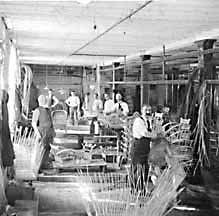 baskets
or various furniture objects, also known as "wickerwork."~ It is
an all-inclusive term regarding the element of an item which is
woven out of one or more types and/or sizes of different natural
raw materials. Wicker is not a material in and of itself; it is
the resulting object fabricated out of organic plant materials such
as rattan, cane, reed and willow, and man-made fibers such as rush.
The word wicker did originate, however, from a combination of Scandinavian
words for a particular material: the Swedish noun vikker
and the Danish noun viger both refer to osiers, the pliable
offshoots of slender new growth on a willow tree, used for weaving.
Additionally, the Swedish verb wika refers to the act of
bending or folding. baskets
or various furniture objects, also known as "wickerwork."~ It is
an all-inclusive term regarding the element of an item which is
woven out of one or more types and/or sizes of different natural
raw materials. Wicker is not a material in and of itself; it is
the resulting object fabricated out of organic plant materials such
as rattan, cane, reed and willow, and man-made fibers such as rush.
The word wicker did originate, however, from a combination of Scandinavian
words for a particular material: the Swedish noun vikker
and the Danish noun viger both refer to osiers, the pliable
offshoots of slender new growth on a willow tree, used for weaving.
Additionally, the Swedish verb wika refers to the act of
bending or folding.
The Victorian Style
The earliest American wicker is classified as Victorian, dating
from the mid-1800s to 1900. A progression of several distinct woven
designs transformed during that period. The initial forms are somewhat
skeletal where wickerwork is simply wrapped over arches and curved
frames. Victorian wicker is mostly recognized, however, for elaborate
and intricate designs of the 1880s-1890s. The fanciful wicker of
the aesthetic movement possesses a sculptural quality as hand woven
works of art. Toward the turn of the century more subdued patterns
were in vogue.
 |
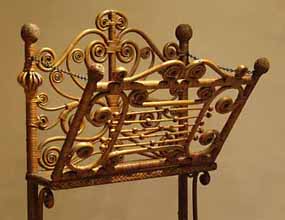 |
|
| The Victorian Style |
|
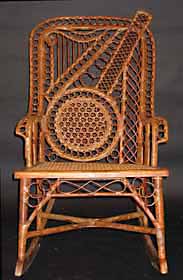 |
| Victorian Motif Wicker |
Victorian Motif Wicker
Motif wicker is an ornate category of Victorian wicker that first
appeared in the 1870s. Motif seating pieces are woven creations
where the back panel becomes the artist's canvas, so to speak. Also
 |
| Photographer's Chair |
referred to as "theme" wicker, the back rest depicts an object, or
multiple objects, in hand-woven wickerwork.
Victorian Wicker
Photographers' Chairs
Wicker photographers' chairs flourished in the Victorian era. Also
known as "posing chairs", these studio props provided an artistic
wicker background for one's formal portrait. The subject would either
perch on the seat or stand beside the chair for the photograph.
These speciality chairs usually have elaborate ornamentation with
a melange of intricate wickerwork. The whimsical patterns and asymmetry
provide an aesthetic visual backdrop.
The Bar Harbor Style
The Bar Harbor style was made from the turn-of-the-century into
the 1920s. It is characterized by hand woven crisscrossed reeds
taking the form of diamond shaped lattice, finished in either a
wide or narrow braided border. The frames of this open and airy
style may be rounded with curves, or rectilinear as in Mission wicker.
The Stick Wicker Style
Stick Wicker is tailored and streamlined having evenly spaced paired
vertical reeds, usually without any overlapping design. Hand-woven
Stick Wicker from the early 1900s-late 1920s is characterized by
a Modernist quality to its often angular frame. Special features
include magazine pockets and glass holders woven into the arms of
seating pieces.
The Art Deco Style
The French inspired Art Deco style of American antique wicker thrived
in the 1920s. Curved and peaked frames, rounded arms and flared
legs feature various basketweave patterns closely woven overall.
Visual interest often includes zig-zag designs, arrows, a diamond
or cluster of diamonds. Lloyd loom wicker is closely woven as well,
but with thinner diameter material. Mass production of wicker became
available in 1917 when looms were used to weave fine reeds or twisted
paper material into large sheets, much like yards of fabric. The
material was then applied to wooden frames by hand.
 |
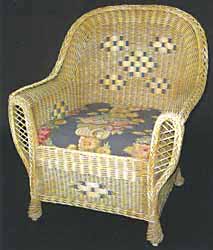 |
|
Art Deco style lamp and chair
|
More Than a Century of
Classic American Wicker
The revival of classic woven furniture began in the 1960s and 70s
and by the 1980s its popularity was thriving once again. Interior
design magazines as well as art and antiques publications reintroduced
American antique wicker on several different levels - appreciation
of its consummate artistry, versatility in decorating virtually
any room setting, and the wide range of wicker work variations made
during the span of the late 19th and early 20th centuries. More
than a dozen books devoted exclusively to the history, design and
care of authentic Americans antique wicker were published through
the 1990s. The reestablished acclaim for the four major styles of
period wicker became comparable to its zenith of the late 1800s
to 1920s. The resurgence of hand woven furniture is appreciated
for its fine workmanship, utility and artistic sculptural qualities.
American wicker has been spotlighted in several historic exhibitions
in the past 100 years. The 1876 Centennial Exhibition in Philadelphia
was the most notable of the distant past. The Wakefield Rattan Co.
of Massachusetts had a significant presence at that first American
World's Fair, and made a huge impact on the popularity of wicker
furniture at that time. Exposure of the company's display of a wide
range of rattan goods led it to become known as the preeminent manufacturer
associated with the American industry of woven furniture.
A contemporary exhibit in 1993, AMERICAN WICKER: Woven
Furniture from 1850 to 1930, was held at the Smithsonian's Renwick
Gallery of the National Museum of American Art in Washington D.C.
Many private collectors and antiques dealers participated in that
exhibition. It was an important and scholarly display and a milestone
for the recognition of the useful and artistic value of American
antique wicker.
 |
Motif
Settee Featuring a Two-Masted Schooner
The first American schooner was launched in Gloucester, Massachusetts
in 1713, built by Capt. Andres Robinson. The name schooner is
legendary, originating from the remark of an admiring bystander
who exclaimed at the launch "Oh, how she schoons!"
like a stone skimming water. As Capt. Robinson christened a
bottle on her bow for its maiden voyage, he proclaimed "Then
a schooner let her be!" This rare wicker sailing motif
indeed "schoons" across the breadth of the settee backrest,
It is believed to be a one of a kind piece of early American
wicker, likely to have been privately commissioned for a prosperous
sea captain's home. It is a proportionate wicker interpretation
of the 2-masted schooners prevalent in the mid-1800s. |
Did You Know?
·Cyrus Wakefield (1811-1873) is considered
to be the founder of the American wicker industry. In 1840 he purchased
rattan in Boston from ships returning from voyages to the Orient.
As an innovatice "grre" entrepreneur, he found a new and
recycled use for the rattan no longer needed to keep the ship's
cargo in place. He established the Wakefield Rattan Co. in South
Reading, Massachsetts in 1855.
·On July 4, 1868 South Reading, Massachusetts,
originally founded in 1644, changed its name to Wakefield in Cyrus
Wakefield's honor.
·Samuel Colt(1814 - 1862), notorious
firearms inventor, also manufactured wicker in Hartford, Connecticut.
Colt Willow Works was a major producer of woven furniture until
1873 when a disastrous fire destroyed Colt's successful business.
·The 1876 Centennial Exhibition in
Philadelphia was a turning point in the popularity of wicker. The
Wakefield Rattan Co. exhibited in the Main Building and captured
the interest of an immense number of visitors.
· In the 1880s several sailing vessels
including Cyrus Wakefield's three-masted clipper ship, The Hoogly,
imported thousands of tons of rattan from Singapore annually for
the thriving American wicker industry.
· After many years of fierce competition,
the Wakefield Rattan Co. and the Heywood Bros. Co. merged in 1897.
The firm Heywood Bros. & Wakefield Co. soon became the largest
importers of rattan and the largest producers of wicker furniture
in the world.
Chatham Historical Society
The mission of the Chatham Historical Society is
to inform and educate present and future generations about the history
and culture of Chatham and vicinity by collecting and preserving
records of earlier generations and by exhibiting and interpreting
art, artifacts, archives, and places of historical interest.
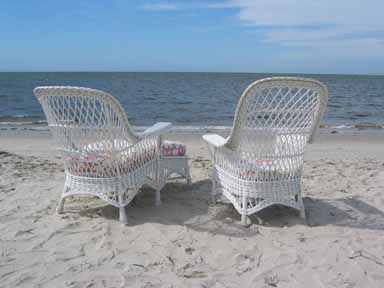
2008 AMERICAN ANTIQUE WICKER EXHIBITION
Chatham Historical Society,
in collaboration with Kathleen and Thomas Tetro of Corner House Antiques of Sheffield
MA (americanantiquewicker.com)
and Mary Jean McLaughlin of Ivorytown, CT.
All photographs and text copywrited CORNER HOUSE ANTIQUES, © 2008
|
 baskets
or various furniture objects, also known as "wickerwork."~ It is
an all-inclusive term regarding the element of an item which is
woven out of one or more types and/or sizes of different natural
raw materials. Wicker is not a material in and of itself; it is
the resulting object fabricated out of organic plant materials such
as rattan, cane, reed and willow, and man-made fibers such as rush.
The word wicker did originate, however, from a combination of Scandinavian
words for a particular material: the Swedish noun vikker
and the Danish noun viger both refer to osiers, the pliable
offshoots of slender new growth on a willow tree, used for weaving.
Additionally, the Swedish verb wika refers to the act of
bending or folding.
baskets
or various furniture objects, also known as "wickerwork."~ It is
an all-inclusive term regarding the element of an item which is
woven out of one or more types and/or sizes of different natural
raw materials. Wicker is not a material in and of itself; it is
the resulting object fabricated out of organic plant materials such
as rattan, cane, reed and willow, and man-made fibers such as rush.
The word wicker did originate, however, from a combination of Scandinavian
words for a particular material: the Swedish noun vikker
and the Danish noun viger both refer to osiers, the pliable
offshoots of slender new growth on a willow tree, used for weaving.
Additionally, the Swedish verb wika refers to the act of
bending or folding. 












